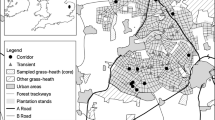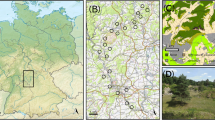Abstract
Although the loss of species is often attributed to reductions in habitat area, heterogeneity and connectivity, species specific traits and taxonomic relatedness can be important in explaining which species groups may be most impacted by the fragmentation process. In this study, using urban grassland fragments within the Front Range of northern Colorado, USA, we quantified the degree to which grasshopper species numbers declined with reductions in habitat area. We then examined the degree to which subfamily grouping (Gomphocerinae, Melanoplinae, Oedipodinae) and variation in life history characteristics (body size, dispersal ability, feeding preference and juvenile emergence time) explained which grasshopper species groups might be most impacted by reductions in habitat size. Our results showed a strong species-area relationship for grasshoppers across the urban fragments. Grasshoppers in different subfamily groupings were found to respond differentially, with the Melanoplinae being least affected by reductions in habitat area, while the other subfamilies responded similarly and lost species at a higher rate. Species with different feeding strategies were also found to respond differentially, with forbivorous species being least affected by the reductions in habitat area, while the graminivorous and herbivorous (mixed-feeders) responded similarly and lost species at a higher rate. As Melanoplinae tend to be forb feeders, this may partially explain why the subfamily was not as affected by the fragmentation process as the Gomphocerinae and Oedipodinae (who tend to be grass and mixed-feeders, respectively). Species that differed in body size and dispersal ability did not display differential responses to reductions in habitat area.

Similar content being viewed by others
References
Alberti M (2005) The effects of urban patterns on ecosystem function. Int Reg Sci Rev 28:168–192. doi:10.1177/0160017605275160
Andersen AN, Ludwig JA, Lowe LM, Rent DCF (2001) Grasshopper biodiversity and bioindicators in Australian tropical savannas: responses to disturbance in Kakadu National Park. Austral Ecol 26:213–222
Baldi A, Kisbenedek T (1997) Orthopteran assemblages as indicators of grassland naturalness in Hungary. Agr Ecosyst Environ 66:121–129
Barbaro L, van Halder I (2009) Linking bird, carabid beetle and butterfly life history traits to habitat fragmentation in mosaic landscapes. Ecography 32:321–333. doi:10.1111/j.1600-0587.2008.05546.x
Bascompte J, Solé R (1996) Habitat fragmentation and extinction thresholds in explicit models. J Anim Ecol 65:465–473
Bergmann DJ, Chaplin SJ (1992) Source correlates of species composition of grasshopper (Orthoptera: Acrididae) communities on Ozark Cedar Glades. Southwest Nat 37:362–371
Bock CE, Bock JH, Grant MC (1992) Effects of bird predation on grasshopper densities in an Arizona grassland. Ecology 73:1706–1717
Bock CE, Jones ZF, Bock JH (2006) Grasshopper abundance in an Arizona rangeland undergoing exurban development. Rangeland Ecol Manage 59:640–647
Capinera JL, Sechrist TS (1982) Grasshoppers (Acrididae) of Colorado: Identification, biology and management. Co Ag Ex S B 584S
Capinera JL, Scott R, Walker TJ (2004) Field guide to grasshoppers, katydids and crickets of the United States and Canada. Cornell University Press, Ithaca, NY
Collinge SK (2000) Effects of grassland fragmentation on insect species loss, colonization, and movement patterns. Ecology 81:2211–2226
Connor EF, McCoy ED (1979) The statistics and biology of the species-area relationship. Am Nat 113:791–833
Davies KF, Margules CR, Lawrence JF (2000) Which traits of species predict population declines in experimental forest fragments? Ecology 81:1450–1461
Davies KF, Margules CR, Lawrence JF (2004) A synergistic effect puts rare, specialized species at greater risk of extinction. Ecology 85:265–271
Debinski DM, Holt RD (2000) A survey and overview of habitat fragmentation experiments. Conserv Biol 14:342–355. doi:10.1046/j.1523-1739.2000.98081.x
Diaz S, Cabido M (2001) Vive la difference: plant functional diversity matters to ecosystem processes. Trends Ecol Evol 16:646–655
Didham RK, Ghazoul J, Stork NE, Davis AJ (1996) Insects in fragmented forests: a functional approach. Trends Ecol Evol 11:255–260
Fahrig L (2003) Effects of habitat fragmentation on biodiversity. Annu Rev Ecol Syst 34:487–515. doi:10.1146/annurev.ecolsys.34.011802.132419
Fischer J, Lindenmayer DB (2007) Landscape modification and habitat fragmentation: a synthesis. Glob Ecol Biogeogr 16:265–280. doi:10.1111/j.1466-8238.2006.00287.x
Fitzpatrick U, Murray TE, Paxton RJ, Breen J, Cotton D, Santorum V, Brown MJF (2007) Rarity and decline in bumblebees—a test of causes and correlates in the Irish fauna. Conserv Biol 136:185–194. doi:10.1016/j.biocon.2006.11.012
Fleishman E, Murphy DD (1999) Patterns and processes of nestedness in a Great Basin butterfly community. Oecologia 119:133–139
Foley JA, DeFries R, Asner GP et al (2005) Global consequences of land use. Science 309:570–574. doi:10.1126/science.1111772
Gangwere SK, Muralirangan MC, Muralirangan M (1997) The bionomics of grasshoppers, katydids and their kin. CAB International, Wallinford
Gaston KJ, Blackburn TM (1996) Conservation implications of geographic range size-body size relationships. Conserv Biol 10:638–646
Gotelli NJ, Colwell RK (2001) Quantifying biodiversity: procedures and pitfalls in the measurement and comparison of species richness. Ecol Lett 4:379–391
Grimbacher PS, Catterall CP, Kitching RL (2008) Detecting the effects of environmental change above the species level with beetles in a fragmented tropical rainforest landscape. Ecol Entomol 33:66–79. doi:10.1111/j.1365-2311.2007.00937.x
Hamback PA, Summerville KS, Steffan-Dewenter I, Krauss J, Englund G, Crist TO (2007) Habitat specialization, body size, and family identity explain lepidopteran density-area relationships in a cross-continental comparison. Proc Natl Acad Sci USA 104:8368–8373. doi:10.1073/pnas.0611462104
Hanski I (1982) On patterns of temporal and spatial variation in animal populations. Ann Zool Fenn 19:21–37
Henle K, Davies KF, Kleyer M, Margules C, Settele J (2004) Predictors of species sensitivity to fragmentation. Biodivers Conserv 13:207–251
Hinners SJ (2008) Pollinators in an urbanizing landscape: Effects of suburban sprawl on a grassland bee assemblage. Dissertation, Boulder, University of Colorado
Hoekstra JM (1998) Conserving Orthoptera in the wild: lessons from Trimerotropis infantilis (Oedipodinae). J Insect Conserv 2:179–185. doi:10.1023/A:1009612317241
Joern A (2005) Disturbance by fire frequency and bison grazing modulate grasshopper assemblages in tall grass prairie. Ecology 86:861–873. doi:10.1890/04-0135
Kindlmann P, Burel F (2008) Connectivity measures: a review. Landsc Ecol 23:879–890. doi:10.1007/s10980-008-9245-4
Kotze DJ, O’Hara RB (2003) Species decline: but why? Explanations of carabid beetle (Coleoptera, Carabidae) declines in Europe. Oecologia 135:138–148. doi:10.1007/s00442-002-1174-3
Lambeets K, Vandegehuchte ML, Maelfait JP, Bonte D (2009) Integrating environmental conditions and functional life history traits for riparian arthropod conservation planning. Biol Conserv 142:625–637. doi:10.1016/j.biocon.2008.11.015
Lassau SA, Hochuli DF, Cassis G, Reid CAM (2005) Effects of habitat complexity on forest beetle diversity: do functional groups respond consistently? Divers Distrib 11:73–82
Lindenmayer DB, Fischer J (2006) Habitat fragmentation and landscape change: an ecological and conservation synthesis. Island Press, Washington, DC
McGill BJ, Enquist BJ, Weiher E, Westoby M (2006) Rebuilding community ecology from functional traits. Trends Ecol Evol 21:178–185. doi:10.1016/j.tree.2006.02.002
McKinney ML (2006) Urbanization as a major cause of biotic homogenization. Biol Conserv 127:247–260. doi:10.1016/j.biocon.2005.09.005
McKinney ML, Lockwood JL (1999) Biotic homogenization: a few winners replacing many losers in the next mass extinction. Trends Ecol Evol 14:450–453
Moritz C (2002) Strategies to protect biological diversity and the evolutionary processes that sustain it. Syst Biol 51:238–254
Nufio CR, McClenahan JL, Thurston EG (2009) Determining the effects of habitat fragment area on grasshopper species density and richness: a comparison of proportional and uniform sampling methods. Insect Conserv Divers 2:295–304. doi:10.1111/j.1752-4598.2009.00065.x
Oedekoven MA, Joern A (1998) Stage-based mortality of grassland grasshoppers (Acrididae) from wandering spider (Lycosidae) predation. Acta Oecol 19:507–515
Otte D (1976) Species richness patterns of new world desert grasshoppers in relation to plant diversity. J Biogeogr 3:197–209
Patterson BD, Atmar W (1986) Nested subsets and the structure of insular mammalian faunas and archipelagoes. Biol J Linn Soc 28:65–82
Pik AJ, Oliver I, Beattie AJ (1999) Taxonomic sufficiency in ecological studies of terrestrial invertebrates. Aust J Ecol 24:555–562
Pysek P (1998) Is there a taxonomic pattern to plant invasions? Oikos 82:282–294
Schnell MR, Pik AJ, Dangerfield JM (2003) Ant community succession within eucalypt plantations on used pasture and implications for taxonomic sufficiency in biomonitoring. Austral Ecol 28:553–565
Schoereder JH, Galbiati C, Ribas CR, Sobrinho TG, Sperber CF, DeSouza O, Lopes-Andrade C (2004) Should we use proportional sampling for species—area studies? J Biogeogr 31:1219–1226
Schouten MA, Verweij PA, Barendregt A, Kleukers RJM, de Ruiter PC (2007) Nested assemblages of Orthoptera species in the Netherlands: the importance of habitat features and life history traits. J Biogeogr 34:1938–1946. doi:10.1111/j.1365-2699.2007.01742.x
Smith TR, Capinera JL (2005) Mandibular morphology of some Floridian grasshoppers. Fla Entomol 88:204–207
St Pierre MJ, Hendrix SD, Lewis CK (2005) Dispersal ability and host-plant characteristics influence spatial population structure of monophagous beetles. Ecol Entomol 30:105–115
Summerville KS, Conoan CJ, Steichen RM (2006) Species traits as predictors of lepidopteran composition in restored and remnant tallgrass prairies. Ecol Appl 16:891–900
Thomas CD (2000) Dispersal and extinction in fragmented landscapes. Proc R Soc Lond B Biol 267:139–145
Tropek R, Kadlec T, Karesova P et al (2010) Spontaneous succession in limestone quarries as an effective restoration tool for endangered arthropods and plants. J Appl Ecol 47:139–147
Tscharntke T, Steffan-Dewenter I, Kruess A, Thies C (2002) Characteristics of insect populations on habitat fragments: a mini review. Ecol Res 17:229–239
Williams PH, Gaston KJ (1994) Measuring more of biodiversity: can higher-taxon richness predict wholesale species richness? Biol Conserv 67:211–217
Willis CG, Ruhfel B, Primack RB, Miller-Rushing AJ, Davis CC (2008) Phylogenetic patterns of species loss in Thoreau’s woods are driven by climate change. Proc Natl Acad Sci USA 105:17029–17033. doi:10.1073/pnas.0806446105
Winter M, Schweiger O, Klotz S et al (2009) Plant extinctions and introductions lead to phylogenetic and taxonomic homogenization of the European flora. Proc Natl Acad Sci USA 106:21721–21725. doi:10.1073/pnas.0907088106
Wright DH, Reeves JH (1992) On the meaning and measurement of nestedness of species assemblages. Oecologia 92:416–428
Acknowledgments
This project was supported by a National Science Foundation Grant (#1543813) and its supplemental REU, a Walker Van Riper research grant, a Bioscience Undergraduate Research Skills and Training internship from the University of Colorado, and a post-doctoral diversity fellowship from the Chancellor’s Office of the University of Colorado, Boulder. We thank land managers at Boulder, Jefferson, Denver and Larimer County Open Space, the home owners association at Niwot Estates and the South Suburban Parks and Recreation for support and access to their properties. We thank Sarah Hinners for access to her research sites and helpful insights and Elizabeth Studer for her work on insect mouthparts. We thank Elizabeth Thurston, Virginia Scott and Johanna Zeh for help processing specimens and thank Robert Guralnick, Christy McCain and two anonymous reviewers who provided valuable insight and improved this manuscript.
Author information
Authors and Affiliations
Corresponding author
Rights and permissions
About this article
Cite this article
Nufio, C.R., McClenahan, J.L. & Deane Bowers, M. Grasshopper response to reductions in habitat area as mediated by subfamily classification and life history traits. J Insect Conserv 15, 409–419 (2011). https://doi.org/10.1007/s10841-010-9314-2
Received:
Accepted:
Published:
Issue Date:
DOI: https://doi.org/10.1007/s10841-010-9314-2




